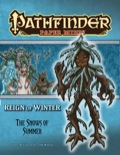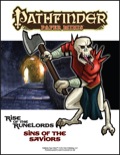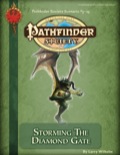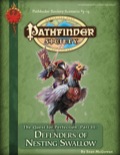|
Sign in to create or edit a product review. I love this set, particularly the ivory dice with brown ink. My gaming group used them in a Firefly-style "Space Western" game, and they fit perfectly. Even though I don't play Fate on a regular basis, these dice are still in my bag, just because they look so good! Great adventures, but you'll need to work for themI bought this compilation primarily for the "Three Rocketeers" adventure. It's a fantastic mashup and works very well. However, like the other Fate products, it does require that the people running the game add a healthy dose of their own creativity in order to make it work. That said, *because* you're adding your own spark to it, the game will very much become what you and your group wants. So it's not a bad thing. Just something to be aware of. The book provides an outline of the setting, the scaffold of an adventure, and a few set-piece encounters. It also discusses ways to tweak the Fate system to match the feel of the adventure. Overall, it's well-written and does the job of providing enough information to get you going. But it's not something you can just pick up and play with no prep. Also, it includes the phrase "The Star Pope." How awesome is that?! This is another high-quality release in the Paper Minis line. As usual, it includes minis for all of the monsters and NPCs encountered in the adventure, and also includes the named NPCs from the town writeups in the appendix. This leads to a versatile set that has everything needed to run the adventure as-written. Yes, this does mean *multiple* copies of creatures that should be encountered in groups, such as Pale Tower Guards and summoned creatures. The art is good, and works well at the size you will be printing these. I actually find the paper minis line better than the Pathfinder Pawns, because the art on the latter was designed to be used in a book, not scaled down for tabletop play. The one minor gripe I have with this set is that while it does include lots of townsfolk NPCs, it does not include two that are actually in the adventure! Namely, Old Man Dansby and Dryden Knepp are not included. Granted, both of these NPCs are found dead the first time they are encountered, but I was hoping to play them up by adding scenes with them earlier in the adventure. Picking this up is a no-brainer for anyone who wants to run Snows of Summer without shelling out tons of money to get the minis needed. It would also be useful for homebrew GMs wanting to run a winter-themed low-level game. Fate Accelerated is designed to be a very easy to learn and quick to play version of the Fate Core rules. It succeeds at this task very well! The main difference between this game and Fate Core is that instead of a full-blown skill system, this book includes only six "approaches": Careful, Clever, Flashy, Forceful, Quick, and Sneaky. PCs will have different rankings in each of these approaches, which make them unique, but is a much simpler system than having a whole skill list with items like Rapport, Shoot, Athletics, and so on. The Aspect system and the underlying mechanics of how the game works (the dice mechanic, fate points, and the different types of actions) are all the same as in Fate Core, so this is a good primer for those parts of the full game as well. The price is also a big selling point. At only $5, you can buy enough for your whole gaming group, and not be worried about keeping them in good condition. Physically, the book is pretty small -- it's only about 50 pages, and is 9" x 6". There isn't a ton of room for examples, which is the only real problem with the book. But it does a good job laying out the rules, so that shouldn't be too much of an issue. A fantastic rulebook at a great price!The System
Fate is a much lighter rules system than a game like D&D or Pathfinder, but it still has a decent amount of “crunch” – it’s not a “pass the stick” kind of indy RPG. What makes this game different, though, is that the rules are not trying to be simulationist, but rather narrative. That is, you get benefits for acting in-character even when doing so would be bad for the character (but interesting for the story). Also, the game rewards coming up with cool ideas, as long as they can be justified in the context of the story. Mechanically, the way this works is with something called “Aspects.” An Aspect is a short phrase or description of something, such as “Superstitious Barbarian” or “Slow as Molasses” or “I Swear Vengeance!” (all of these examples are from characters in my current Fate group). Players can earn Fate Points whenever their Aspects cause them complications in the game. For example, when the Superstitious Barbarian encounters a piece of high technology, he might earn a Fate point for smashing it rather than using it to his advantage. He could then later spend the Fate point to “invoke” his Superstitious Barbarian aspect and gain a bonus on, say, attacking an enemy (since that’s something a barbarian would be good at). Aspects are free-form – there is no set list of possible aspects. The players make up whatever would be appropriate during character creation.
Overall, this system results in a fast-paced, rules-light game that still has enough of a mechanical crunch to be interesting. It really encourages getting in character, even when doing so would not be in the best interest of the PC. And when things get really dicey, the game rewards the “rule of cool” when coming up with solutions. The Book
Art is not as good as what you might expect from a Pathfinder book, but it’s interesting and gets the job done. It’s all black and white, but it looks good and is well laid out. There is an index, which is only a single page. However, in the short time I’ve been playing, there hasn’t been anything I’ve needed to look up and not been able to find. So the topics seem to have been chosen pretty well. There are also cross-references in the margins of the text that refer to sections of the book relevant to what is being discussed. One minor thing to note is that this book is physically smaller than I’m used to for gaming books. It’s only 9” x 6”, compared to 8.5” x 11” like a Pathfinder or D&D book. That does make it more difficult to stuff character sheets and the like into the book, but also makes it easier to carry. The Sins of the Saviors paper minis set is another excellent addition to the line. With all the minis needed to run the 5th volume of the first Pathfinder AP, there are a *lot* of minis here! Most of the creatures in this set are humanoids, as fits the adventure. The highlight is the hordes of Warriors of Wrath and Sinspawn Axemen, which really make the fights in the Wrath wing feel epic. The Shemhazian Demon is also a fantastic addition, and looks great on the table! The tongue-in-cheek complaint about this set is that there are no minis provided for the PCs' evil doppelgangers! However, on a more serious note, the set does have a few issues. The Hounds of Tindalos and Lamashtu look great, but are so dark that any details get lost in what looks on the table like just a silhouette. Also, the set is missing a couple "flavor" pieces, such as the giant peacock from the Shimmering Veils. Also, be aware that the set has not (yet) been updated for the new Anniversary Edition of Rise of the Runelords, though hopefully that will be remedied soon. Overall, you can't go wrong with this set, particularly if you are planning to run Sins of the Saviors. For a fraction of the price of plastic or metal minis, and a modest investment of time, you can have all the bad guys you will need to run this very fun adventure! Overall, this was a fun and flavorful module. As a player, I was a bit worried going in that this would be an overwhelmingly combat-focused slugfest, but it turns out that the setting is very flavorful, and the puzzles were entertaining. My only real complaint is that it's a fairly long scenario, and the end battle is complex enough that it will take a *long* time to run. Our group ended up running out of time in our Gen Con slot before reaching the end. If you GM this module, you will need to push your players and keep up the momentum of the game in order to avoid running long, particularly if you have 6 or 7 players. *note: some spoilers in this review*, though the premise is straightforward enough that I doubt it will be too much of an issue. This is an excellent module, and a great conclusion to the Quest for Perfection arc -- even if the plot is a complete rip-off of a certain Kurosawa film. But then, if you're going to borrow from something, why not something good? plot overview, with comments:
The module begins with a simple combat encounter that sets up the Bad Guys and gets the PCs into the town. There, they find out about the bandits and quickly start setting in motion plans for the defense of the town.
At this point, the module switches into a kind of resource-management mini game, where the PCs must allocate villagers toward various defensive preparations (building barricades, training archers, and so forth). This subsystem might not be for everyone, but most of the players at my table really got into it. The new mechanics can be a little confusing at times -- they work well when the GM is prepared, but care should be taken to make sure you understand the way this works before attempting to run the module. I actually made up a couple of handouts for my players to help them grok the system; I will post links in the Discussion thread for this module. Building up the defenses earns the PCs Defense Points, which can be spent during the Big Battle to add to various rolls and checks. I *highly* recommend having some kind of physical marker for these: poker chips, dice, or whatever. If you don't give the players something to sit in front of them, they are likely to forget the fact that they have these points available. The second half or so of the module is the actual battle, which comes in waves. I found the different combat waves were varied enough to be interesting, and though they strayed close to becoming repetitive, I think they managed to avoid crossing that line. However, it seemed to me that there were not really enough bandits to make the fight seem really epic. Particularly when the PCs have earned a lot of defense points, there are *very* few bandits in each wave. This makes them seem more like a trickle than a tide, and with defensive fortifications set up, the PCs will slaughter them with very little chance of actually taking damage. Particularly in the first encounter, there were only two bandits in the first wave, three in the second, and only one in the third! (Note that these numbers are after modifications from a high Defense score, which my PCs managed to get the maximum benefit from). Given the way the encounters are timed in the scenario, the PCs ended up waiting around several rounds between each group, and only one PC even took any damage in this encounter! The optional encounter with the Owlbear was the most challenging out of the whole scenario, in my experience, which was a little odd. But it was good variety, and a nice break from a constant trickle of Tengu. The final encounter with the bandit leader is interesting, but given the PCs defensive fortifications, he is not able to effectively use his mobility to his advantage. Thus, the fight becomes quite easy. Still, it is a flavorful encounter, and should be fairly interesting. Ultimately, the module is a great deal of fun, but it won't be for everyone. Some PCs will like the resource management aspect of the scenario, while others will not be as interested. This just comes down to knowing your group. The combat is end-loaded, which completely makes sense for the story, but means that players who do not enjoy combat as much may start to get bored by the end. The story itself works well, and has a nice arc to it. This module is a satisfying conclusion to the Quest for Perfection series. Some notes on faction missions:
The faction missions for this module do integrate very nicely into the plot, and avoid the common problem of seeming "tacked on." However, some of the missions tie into the new Defense Point subsystem in ways that the PCs probably will not be able to figure out. For example, the Shadow Lodge mission requires that the PC only use Defense Points to increase Armor Class. But given that the Defense Point subsystem is abstract, there is no way to know from a player's perspective that, for example, spending DP to increase a saving throw or escape a grapple would result in losing the faction mission. I would highly recommend that GMs simply tell impacted PCs flat-out what they need to do with their DP in the battle regarding faction missions; otherwise it will be mostly blind luck that determines whether PCs succeed or not.
Also, the Sczarni mission, while totally in keeping with the faction's goals, will definitely make some Good-aligned characters uncomfortable. I personally have a Chaotic Good Sczarni PC, and this is the first faction mission I've seen where if I were playing the module, I would either have to flat-out ignore my faction mission, or else break character in order to do it. I'm not saying this is necessarily a bad thing (it definitely reinforces the flavor of the faction and provides good hooks for roleplay), but it does mean that some players might be upset. This is a great product for DMs who don't want to spend a ton of cash to get plastic minis, but like to have minis more specific than, "OK, guys, the troll is actually an ogre, and the chaos beast will be the tentamort. . ." The art does have its own style, which may not be to everyone's liking. But my group finds these very enjoyable. They are not too difficult to assemble, and they are cheap enough that you can actually print out that army of ogres to attack the Party. I particularly enjoyed the Huge minis in this set, the Tentamort and the Mother of Oblivion (aka Black Magga). The ogres are the other highlight of this set, and there is a good variety of them (although pages 8 and 10 seem to have the exact same spread of ogres. I'm not sure why they are duplicated). I was a little disappointed with the Black Arrows; I would have preferred them to look a bit more haggard, based on how they were described in the module. But I suppose this way they can be used longer, if your PCs end up convincing them to stick around. All in all, this is a well-produced product that will see a lot of use at my table. I can't wait for the next set! |












